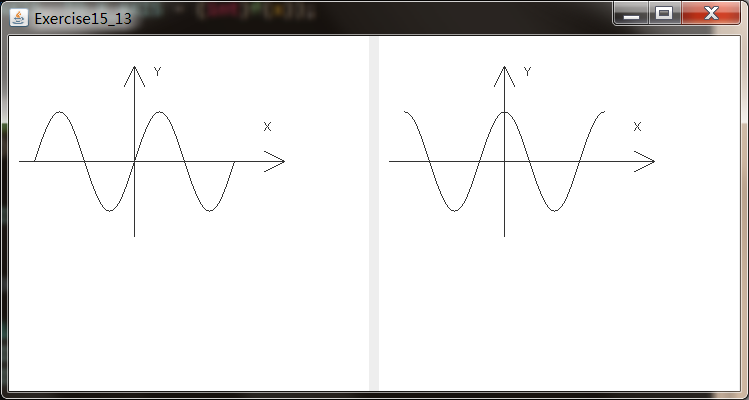【JAVA語言程式設計基礎篇】--圖形-- 使用抽象方法繪製函式圖形
阿新 • • 發佈:2019-01-30
一個很好的運用抽象類的例子
<span style="font-size:14px;">package chapter15_程式設計練習題; import java.awt.*; import javax.swing.*; @SuppressWarnings("serial") public class Exercise15_13 extends JFrame { public Exercise15_13() { setLayout(new GridLayout(1, 2,10,10)); add(new DrawSine()); add(new DrawCosine()); } public static void main(String[] args) { Exercise15_13 frame = new Exercise15_13(); frame.setSize(400, 400); frame.setTitle("Exercise15_13"); frame.setDefaultCloseOperation(JFrame.EXIT_ON_CLOSE); frame.setLocationRelativeTo(null); // Center the frame frame.setVisible(true); } } @SuppressWarnings("serial") class DrawXSquare extends AbstractDrawFunction {//y=x平方 /**Implement the fuction*/ public double f(double x) { // scaleFactor for adjusting y coordinates double scaleFactor = 0.01; return scaleFactor * x * x; } } @SuppressWarnings("serial") class DrawSine extends AbstractDrawFunction {//sin public double f(double x) { return 50 * Math.sin((x / 100.0) * 2 * Math.PI); } } @SuppressWarnings("serial") class DrawCosine extends AbstractDrawFunction {//cos public double f(double x) { return 50 * Math.cos((x / 100.0) * 2 * Math.PI); } } @SuppressWarnings("serial")//抽象類 abstract class AbstractDrawFunction extends JPanel { /**Polygon to hold the points*/ private Polygon p = new Polygon(); final int TO_X_AXIS = 125; final int TO_Y_AXIS = 125; final int END_OF_X_AXIS = 275; final int END_OF_Y_AXIS = 200; /**Default constructor*/ protected AbstractDrawFunction() {//建構函式 drawFunction(); setBackground(Color.white); } /**Draw the function*/ public abstract double f(double x); /**Obtain points for x coordinates 100, 101, ..., 300*/ public void drawFunction() {//繪製曲線圖形點 for (int x = -100; x <= 100; x++) { p.addPoint(x + TO_Y_AXIS, TO_X_AXIS - (int)f(x)); } } /**Paint the function diagram*/ protected void paintComponent(Graphics g) { super.paintComponent(g); // Draw x axis g.drawLine(10, TO_X_AXIS, END_OF_X_AXIS, TO_X_AXIS); // Draw y axis g.drawLine(TO_Y_AXIS, 30, TO_Y_AXIS, END_OF_Y_AXIS); // Draw arrows on x axis g.drawLine(END_OF_X_AXIS, TO_X_AXIS, END_OF_X_AXIS - 20, TO_X_AXIS - 10); g.drawLine(END_OF_X_AXIS, TO_X_AXIS, END_OF_X_AXIS - 20, TO_X_AXIS + 10); // Draw arrows on y axis g.drawLine(TO_Y_AXIS, 30, TO_Y_AXIS - 10, 50); g.drawLine(TO_Y_AXIS, 30, TO_Y_AXIS + 10, 50); // Draw x, y g.drawString("X", END_OF_X_AXIS - 20, TO_X_AXIS - 30); g.drawString("Y", TO_Y_AXIS + 20, 40); // Draw a polygon line by connecting the points in the polygon g.drawPolyline(p.xpoints, p.ypoints, p.npoints); } }</span>

